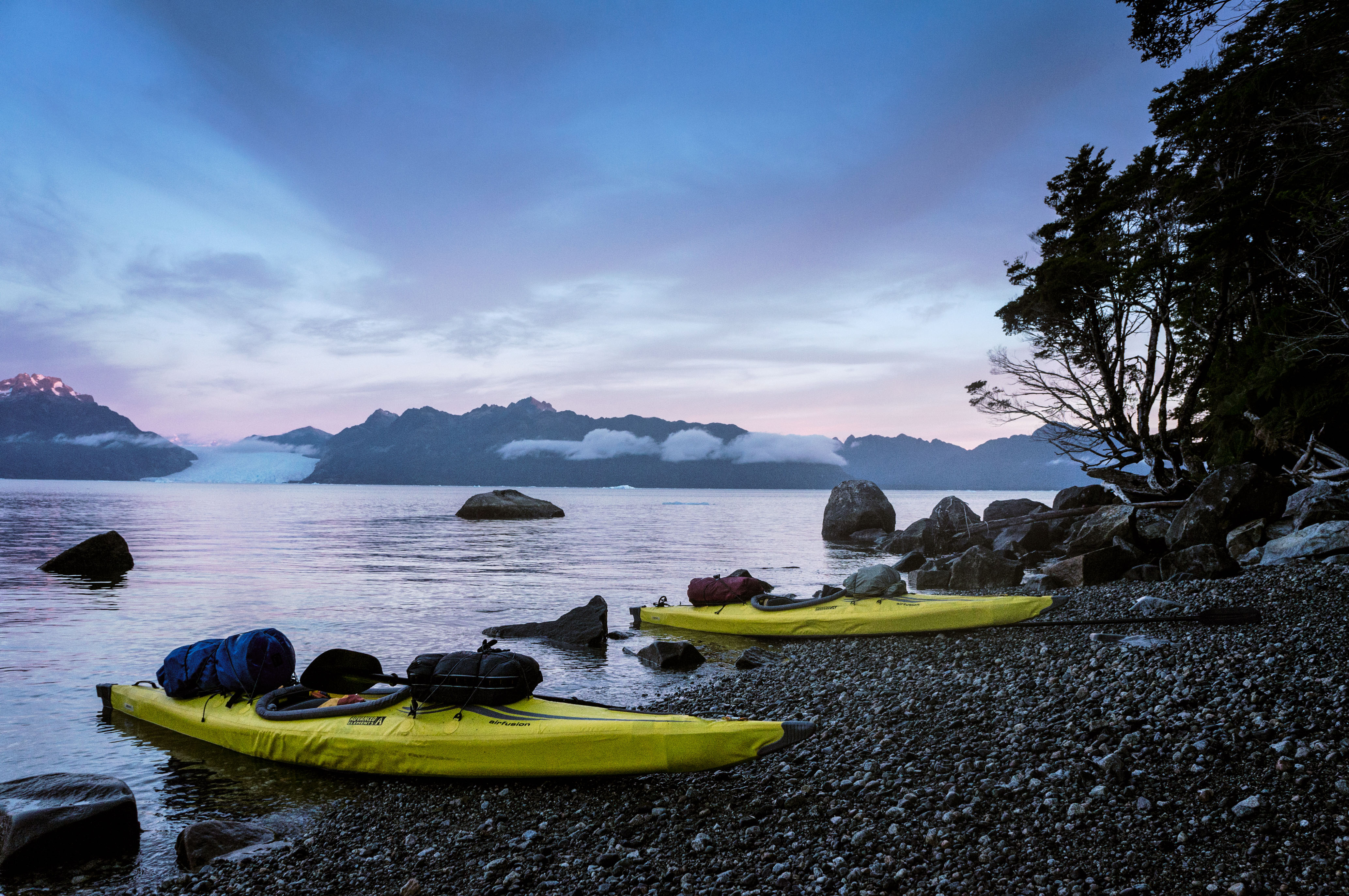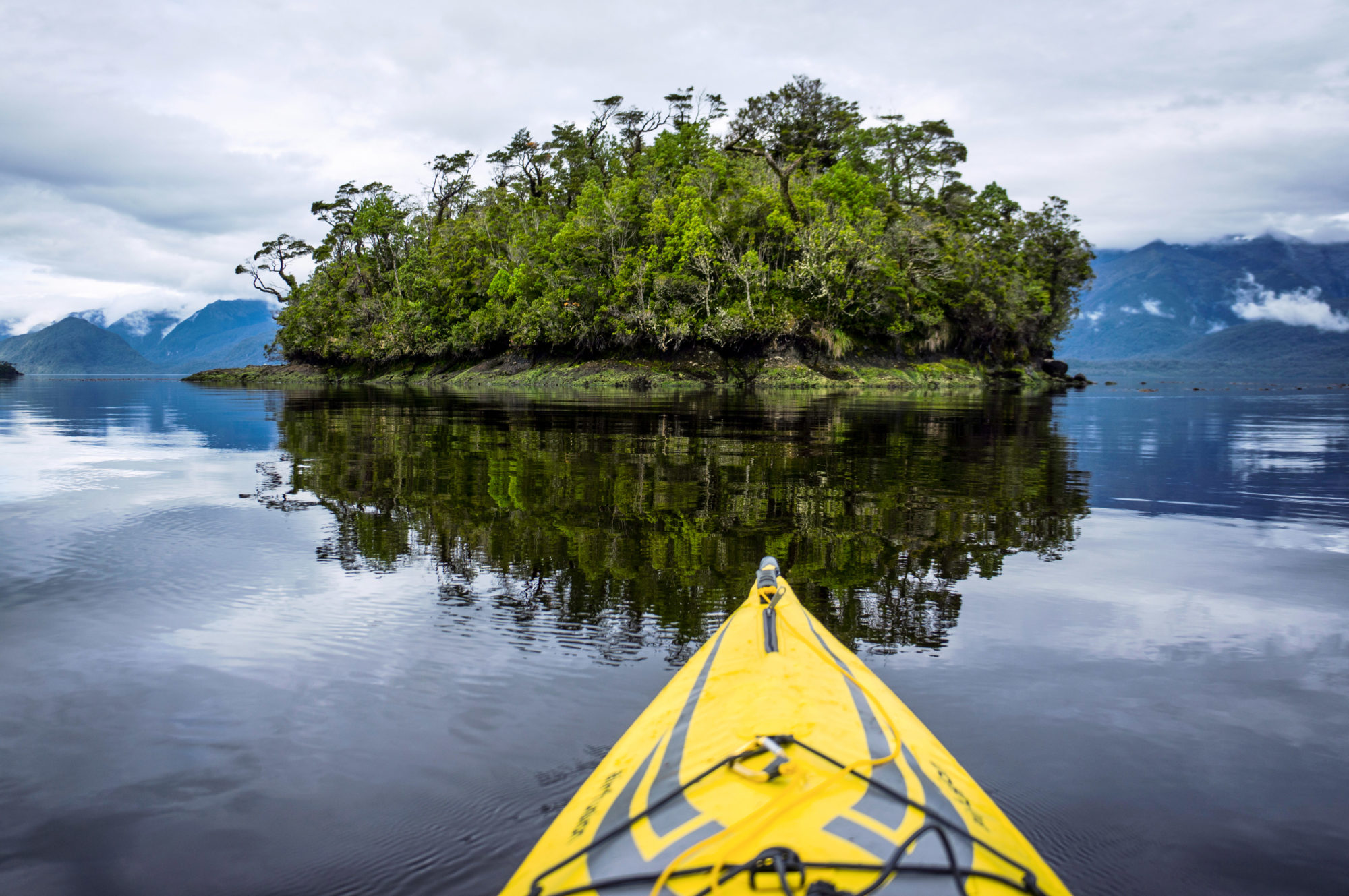I will never forget that moment when we left the muddy bank of the Rio Exploradores. It was late March and had been flooding for days, a river in flood that was bubbling filthy between the banks covered by an impenetrable forest. The current had immediately catapulted us towards the Pacific Ocean: our kayaks were overloaded with gears and food for two weeks of complete autonomy.

Behind of Hielo Norte – A Calze GM Adventure

We could not have been imagined what we were going to face even though we had minutely studied the satellite images of the fjords behind the icy ice sheet of the Hielo Continental Norte.
At that time we could only intensely live the present and ride the huge waves trying to avoid the biggest eddies and trees carried by the current.
I was with my friend Silvano in the heart of the Chilean Patagonia to discover one of its wildest corners. Together we have climbed a thousand mountains in the past but this time we wanted to get in the game with a means of transport that has always fascinated us: the kayak, used for ages by the Inuit of Greenland, and that still today it is surprisingly the same. Our kayaks weighed only 15 kg and had an aluminum skeleton and a plastic skin, in order to be folded for transport.
Thanks to the current we quickly traveled for several kilometers until we found, at the mouth of the river, a suitable place to land and camp. The forest around was a green wall dripping with water. It was raining hard and non-stop. We were in one of the rainiest areas on the planet.
Leaving the estuary of the Rio Exploradores, we cruised south along a long fjord. The mountains fall vertically into the sea. We realized very soon that there was no place for us. We just could get off the kayaks for short breaks on the rocks only at low tide. Finding a place for the tents was really difficult. Often during the night the water rose and reached our shelter: we slept in watertight suits always ready to leave.
“We could not have been imagined what we were going to face even though we had minutely studied the satellite images of the fjords behind the icy ice sheet of the Hielo Continental Norte.
At that time we could only intensely live the present and ride the huge waves trying to avoid the biggest eddies and trees carried by the current.”
After a few days we entered the San Rafael lagoon. On our left there was a giant glacier sinking into the water, releasing innumerable icebergs. Some had strange forms of dragons, others, made of very ancient ice, were so transparent and looked like crystals, others again were a shade of blue never seen before. We sailed among sparkling floating sculptures, and moved in ecstatic silence, kidnapped by the magnetism of the ice.
The southwest part of the lagoon touches the Isthmus of Ofqui, a strip of marshy land that prevents navigation between the northern and southern fjords of Patagonia. For the Indians living in these regions it was not an obstacle, since they also moved with relatively light canoes. In the 1950s the Chilean government decided to cut the Isthmus with a canal: the project soon collapsed in those remote waters but still today the sign of the excavation remains, which is really more like a muddy ditch than a navigable canal.
As we were Indians, we also dragged our kayaks with our knees in the mud, opening a gap in the vegetation under a grey leaden sky. Those were only some kilometers of “portage” and yet, when we reached the new waterway, it seemed as we just came out of a grueling struggle.
The Rio Negro honors its name: we put the kayaks back on the water on an ink bed. It was nice though, the river run slowly and we had plenty of time to enjoy the view. Our attention was catalyzed beyond the dark marshes to the east, from a formidable barrier of frozen mountains. The wild peaks of the Hielo Continental Norte.
Then the wind brought us the smell of the ocean. There was a supernatural calm when we landed on a huge beach, in front of the Golfo de Penas. Big waves touched the dark beach with a slow and quiet rhythm. Time remained suspended between one wave and another while the entire region seemed to be what remained of a sacred prehistory, devoid of human complication.
We were alone, euphoric for the inexpressible beauty in which we felt immersed.
We sat on a dune with the Pacific Ocean in front of us and suddenly we found ourselves tired, tired of wandering for days and hours, tired of eating freeze-dried food and always being wet. That evening, in the curtain, observing our path on satellite images, we decided that it is time to turn the bow to the north.
Going up the Rio without the help of the tide proved to be a nightmare, also thanks to a sudden hail storm: it fell over us like a slap of water and ice that forced us to cling to the shore. It was so violent that we couldn’t even talk to each other, we just hanged there closed in our tight suits, alone with our thoughts, huddled in the kayak.
Going back was psychologically more difficult, because of the lack of motivation that usually pushes you towards the goal. We proceeded too slowly and we were forced to spend a night in the swamp. With the tent mounted on a floating island between the quagmire and the nocturnal mists, we fell into a deep sleep.
The sky became pale going into the day as I stood outside the tent distracted by a dream I had already forgotten. A hummingbird flew fast by me as I watched the grebes slip into the water that looked like molten metal. We had to go back on our liquid road. While we were sailing into the fog, Silvano sang mountain songs, perhaps to make us feel less isolated from the world.

We crossed the Laguna San Rafael again. This time we walked along its eastern edge, passing right in front of the glacier. We were very worried, even sailing at a safe distance. We cruised with extreme caution, trying to guard the best passage between galaxies of blocks of ice: it was a concert of crunches and booms. Every time a bigger piece came off the front of the glacier, a thunder shook the air while a huge solitary wave spread rapidly throughout the lagoon, hitting the coast and the floating ice.
Then the calm returned, broken only by the cheerful passage of a formation of squawking black-necked swans.
It was raining, like every other days. We loaded the kayaks for the last day of navigation. Our arms moved by inertia, our stomachs empty, the beards longer. The current was always upstream. Were we really moving forward or was current dragging us back? Travelling on the water we have learned that the movement, the direction, the length of the travel itself belong to a less certain dimension than one we are used when on the mainland. Perhaps the Lagoon didn’t want to let us go. I confess that even today I hear the water calling me and who knows, maybe one day I will want to listen to it again.
Share this Feature